Applying Informatics to Address Challenges Faced by Samsung Electronics
VerifiedAdded on 2023/04/21
|10
|2278
|484
AI Summary
This document discusses the application of informatics in addressing the challenges faced by Samsung Electronics. It explores the classical themes of informatics and how they can help the company analyze data, understand market trends, and stay ahead of the competition. The document also highlights the importance of proper naming, communication, representation, recording, and systematization in the informatics process.
Contribute Materials
Your contribution can guide someone’s learning journey. Share your
documents today.
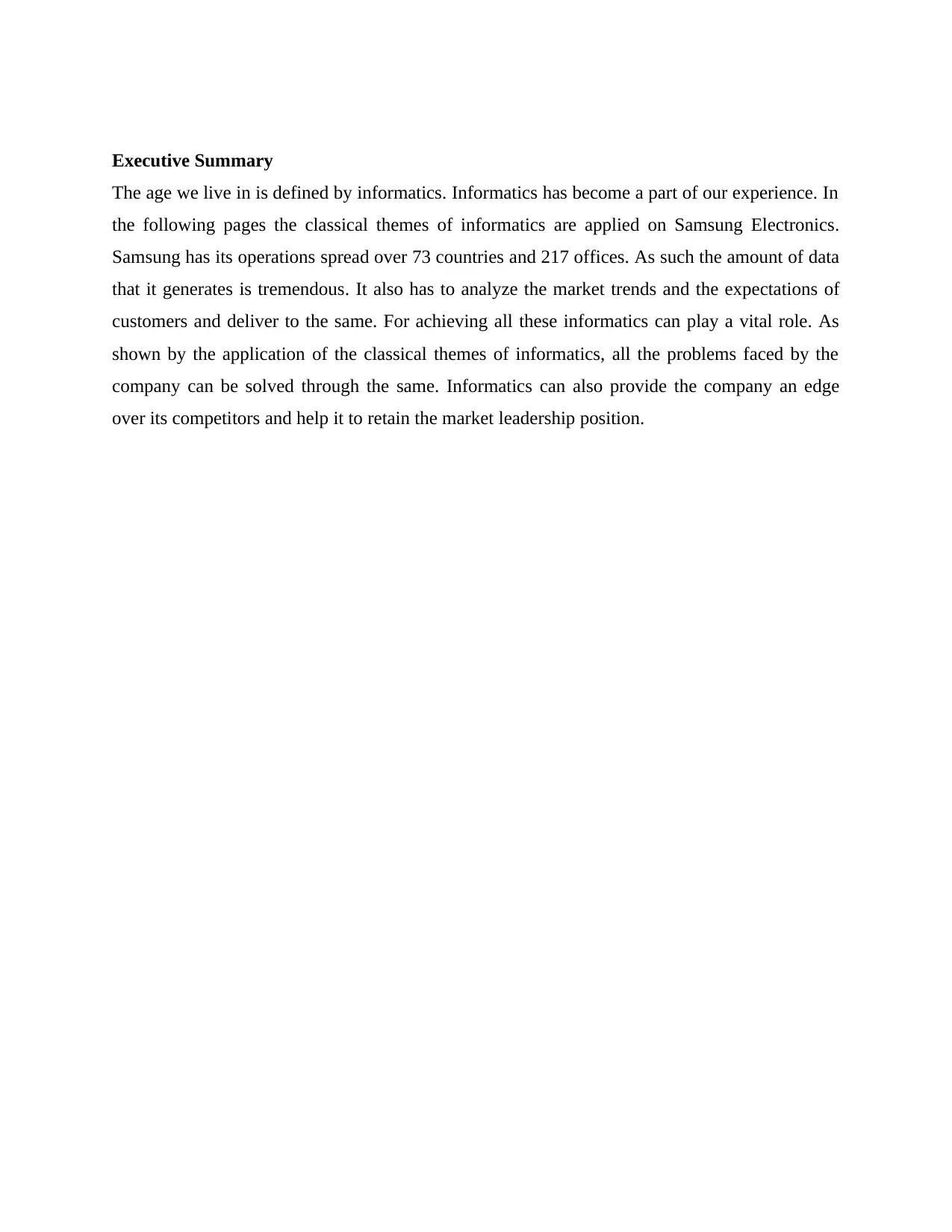
Executive Summary
The age we live in is defined by informatics. Informatics has become a part of our experience. In
the following pages the classical themes of informatics are applied on Samsung Electronics.
Samsung has its operations spread over 73 countries and 217 offices. As such the amount of data
that it generates is tremendous. It also has to analyze the market trends and the expectations of
customers and deliver to the same. For achieving all these informatics can play a vital role. As
shown by the application of the classical themes of informatics, all the problems faced by the
company can be solved through the same. Informatics can also provide the company an edge
over its competitors and help it to retain the market leadership position.
The age we live in is defined by informatics. Informatics has become a part of our experience. In
the following pages the classical themes of informatics are applied on Samsung Electronics.
Samsung has its operations spread over 73 countries and 217 offices. As such the amount of data
that it generates is tremendous. It also has to analyze the market trends and the expectations of
customers and deliver to the same. For achieving all these informatics can play a vital role. As
shown by the application of the classical themes of informatics, all the problems faced by the
company can be solved through the same. Informatics can also provide the company an edge
over its competitors and help it to retain the market leadership position.
Secure Best Marks with AI Grader
Need help grading? Try our AI Grader for instant feedback on your assignments.
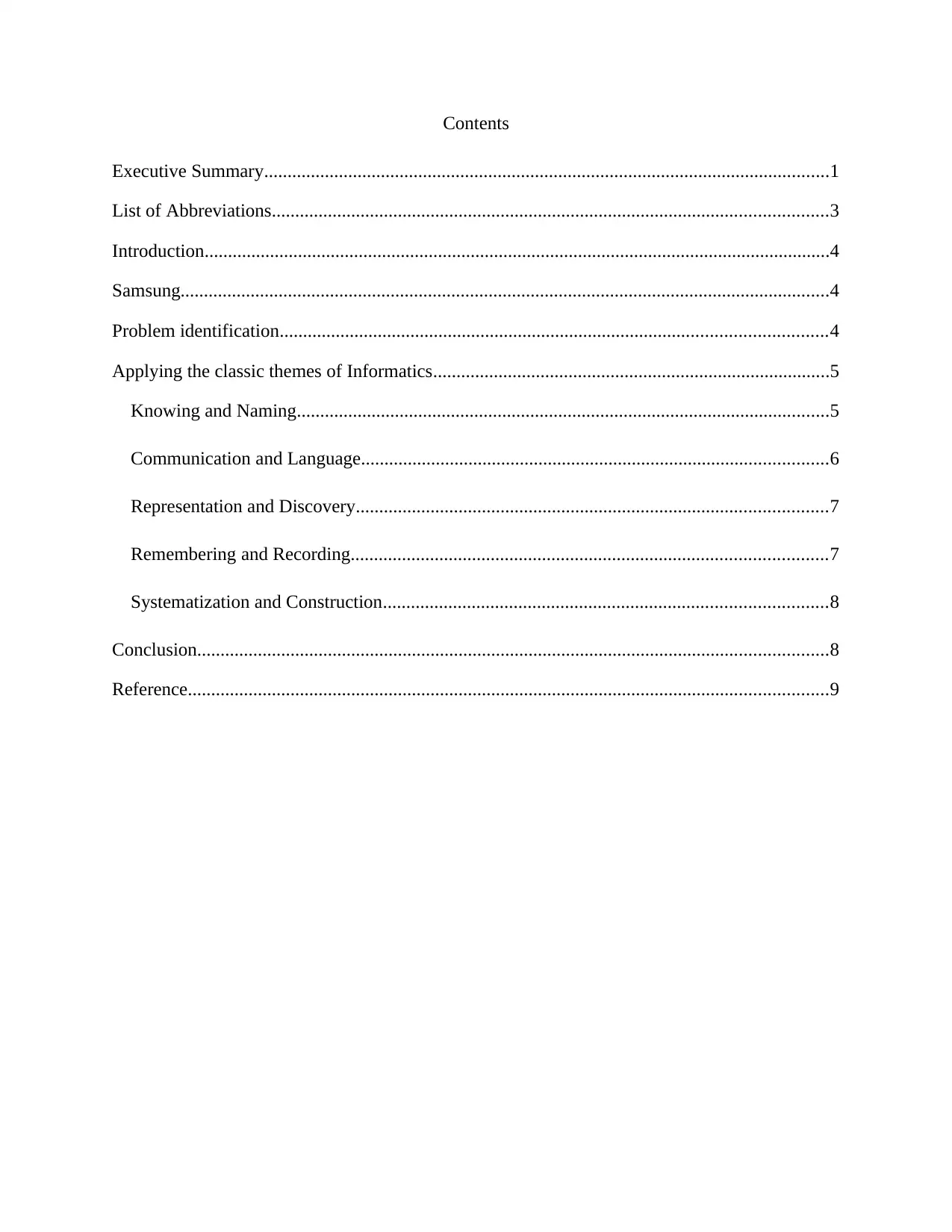
Contents
Executive Summary.........................................................................................................................1
List of Abbreviations.......................................................................................................................3
Introduction......................................................................................................................................4
Samsung...........................................................................................................................................4
Problem identification.....................................................................................................................4
Applying the classic themes of Informatics.....................................................................................5
Knowing and Naming..................................................................................................................5
Communication and Language....................................................................................................6
Representation and Discovery.....................................................................................................7
Remembering and Recording......................................................................................................7
Systematization and Construction...............................................................................................8
Conclusion.......................................................................................................................................8
Reference.........................................................................................................................................9
Executive Summary.........................................................................................................................1
List of Abbreviations.......................................................................................................................3
Introduction......................................................................................................................................4
Samsung...........................................................................................................................................4
Problem identification.....................................................................................................................4
Applying the classic themes of Informatics.....................................................................................5
Knowing and Naming..................................................................................................................5
Communication and Language....................................................................................................6
Representation and Discovery.....................................................................................................7
Remembering and Recording......................................................................................................7
Systematization and Construction...............................................................................................8
Conclusion.......................................................................................................................................8
Reference.........................................................................................................................................9
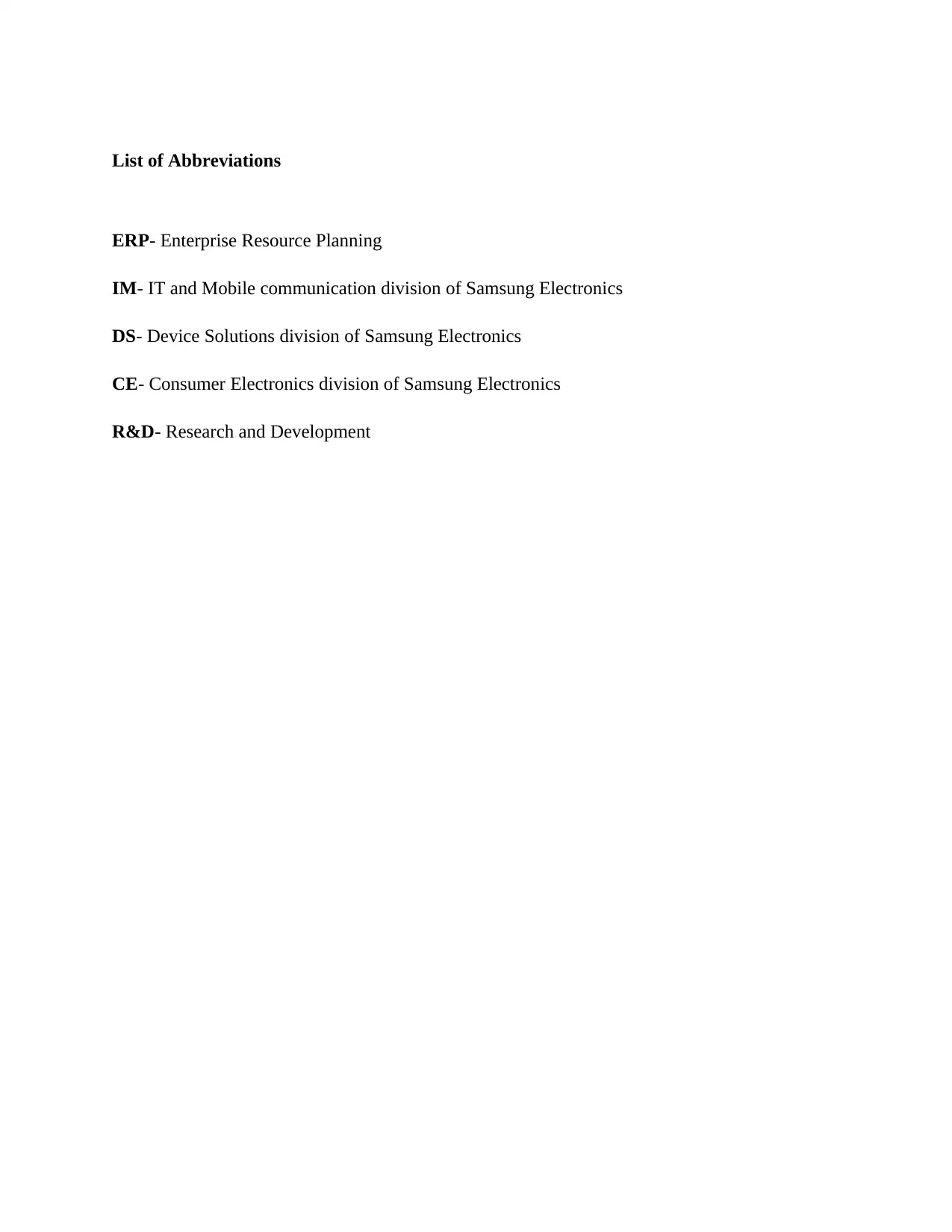
List of Abbreviations
ERP- Enterprise Resource Planning
IM- IT and Mobile communication division of Samsung Electronics
DS- Device Solutions division of Samsung Electronics
CE- Consumer Electronics division of Samsung Electronics
R&D- Research and Development
ERP- Enterprise Resource Planning
IM- IT and Mobile communication division of Samsung Electronics
DS- Device Solutions division of Samsung Electronics
CE- Consumer Electronics division of Samsung Electronics
R&D- Research and Development
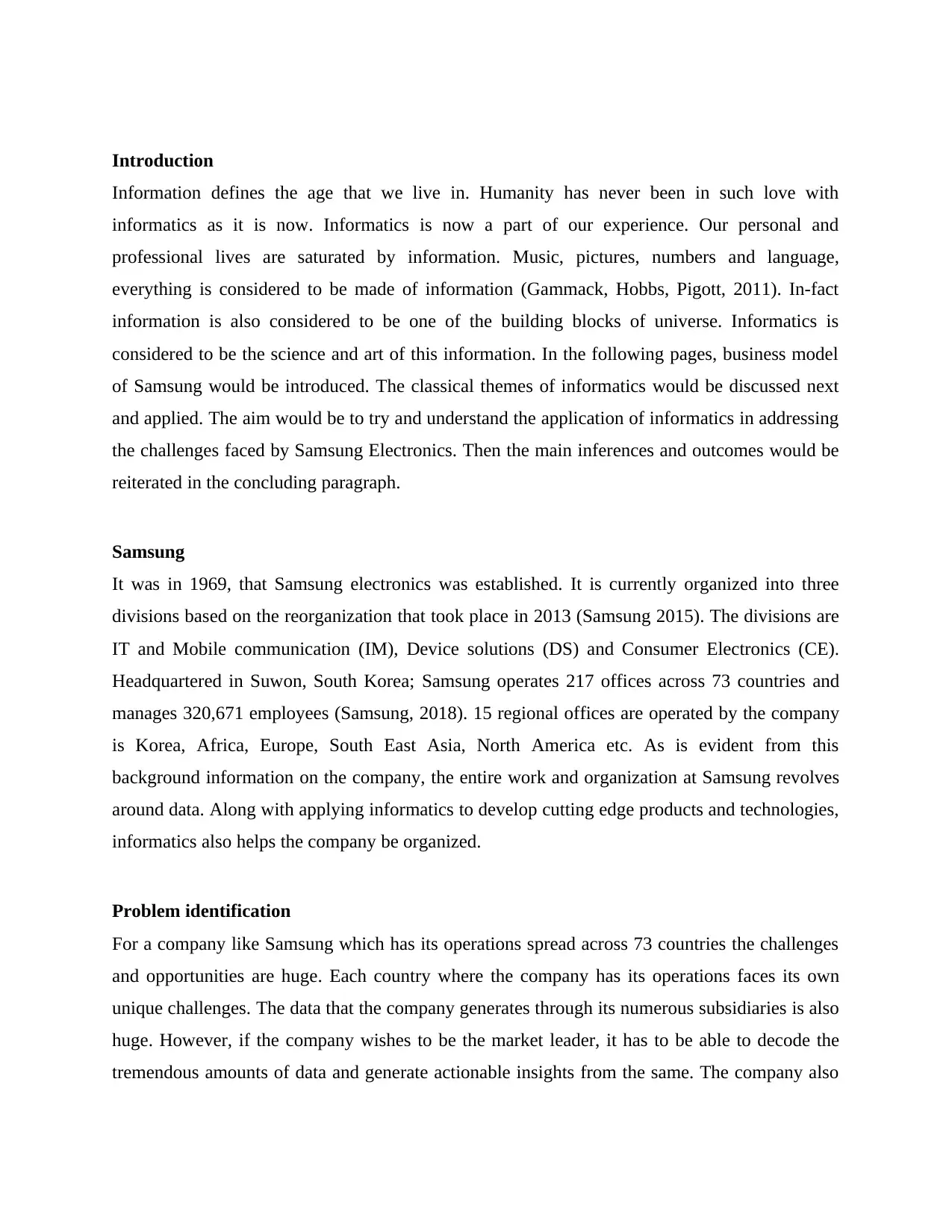
Introduction
Information defines the age that we live in. Humanity has never been in such love with
informatics as it is now. Informatics is now a part of our experience. Our personal and
professional lives are saturated by information. Music, pictures, numbers and language,
everything is considered to be made of information (Gammack, Hobbs, Pigott, 2011). In-fact
information is also considered to be one of the building blocks of universe. Informatics is
considered to be the science and art of this information. In the following pages, business model
of Samsung would be introduced. The classical themes of informatics would be discussed next
and applied. The aim would be to try and understand the application of informatics in addressing
the challenges faced by Samsung Electronics. Then the main inferences and outcomes would be
reiterated in the concluding paragraph.
Samsung
It was in 1969, that Samsung electronics was established. It is currently organized into three
divisions based on the reorganization that took place in 2013 (Samsung 2015). The divisions are
IT and Mobile communication (IM), Device solutions (DS) and Consumer Electronics (CE).
Headquartered in Suwon, South Korea; Samsung operates 217 offices across 73 countries and
manages 320,671 employees (Samsung, 2018). 15 regional offices are operated by the company
is Korea, Africa, Europe, South East Asia, North America etc. As is evident from this
background information on the company, the entire work and organization at Samsung revolves
around data. Along with applying informatics to develop cutting edge products and technologies,
informatics also helps the company be organized.
Problem identification
For a company like Samsung which has its operations spread across 73 countries the challenges
and opportunities are huge. Each country where the company has its operations faces its own
unique challenges. The data that the company generates through its numerous subsidiaries is also
huge. However, if the company wishes to be the market leader, it has to be able to decode the
tremendous amounts of data and generate actionable insights from the same. The company also
Information defines the age that we live in. Humanity has never been in such love with
informatics as it is now. Informatics is now a part of our experience. Our personal and
professional lives are saturated by information. Music, pictures, numbers and language,
everything is considered to be made of information (Gammack, Hobbs, Pigott, 2011). In-fact
information is also considered to be one of the building blocks of universe. Informatics is
considered to be the science and art of this information. In the following pages, business model
of Samsung would be introduced. The classical themes of informatics would be discussed next
and applied. The aim would be to try and understand the application of informatics in addressing
the challenges faced by Samsung Electronics. Then the main inferences and outcomes would be
reiterated in the concluding paragraph.
Samsung
It was in 1969, that Samsung electronics was established. It is currently organized into three
divisions based on the reorganization that took place in 2013 (Samsung 2015). The divisions are
IT and Mobile communication (IM), Device solutions (DS) and Consumer Electronics (CE).
Headquartered in Suwon, South Korea; Samsung operates 217 offices across 73 countries and
manages 320,671 employees (Samsung, 2018). 15 regional offices are operated by the company
is Korea, Africa, Europe, South East Asia, North America etc. As is evident from this
background information on the company, the entire work and organization at Samsung revolves
around data. Along with applying informatics to develop cutting edge products and technologies,
informatics also helps the company be organized.
Problem identification
For a company like Samsung which has its operations spread across 73 countries the challenges
and opportunities are huge. Each country where the company has its operations faces its own
unique challenges. The data that the company generates through its numerous subsidiaries is also
huge. However, if the company wishes to be the market leader, it has to be able to decode the
tremendous amounts of data and generate actionable insights from the same. The company also
Secure Best Marks with AI Grader
Need help grading? Try our AI Grader for instant feedback on your assignments.
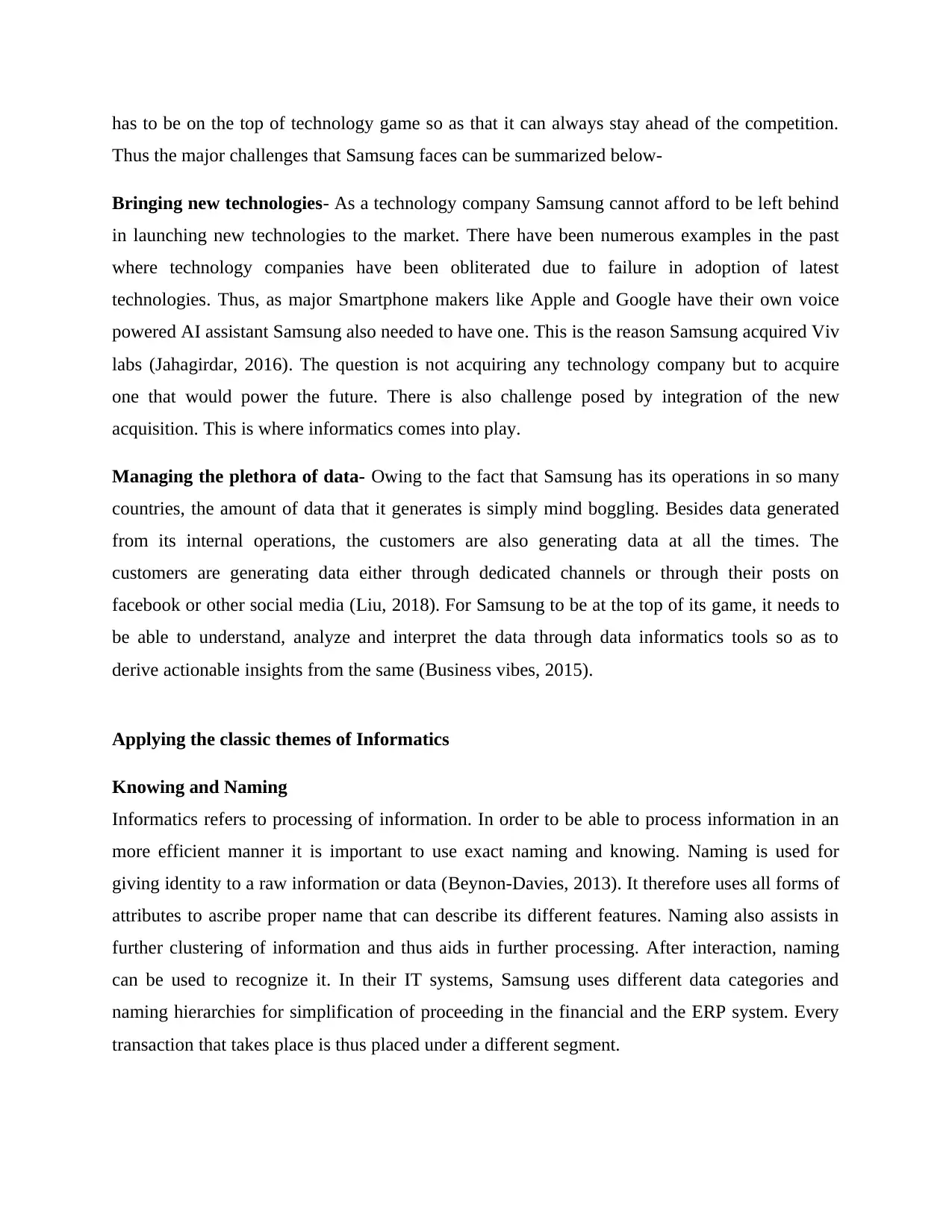
has to be on the top of technology game so as that it can always stay ahead of the competition.
Thus the major challenges that Samsung faces can be summarized below-
Bringing new technologies- As a technology company Samsung cannot afford to be left behind
in launching new technologies to the market. There have been numerous examples in the past
where technology companies have been obliterated due to failure in adoption of latest
technologies. Thus, as major Smartphone makers like Apple and Google have their own voice
powered AI assistant Samsung also needed to have one. This is the reason Samsung acquired Viv
labs (Jahagirdar, 2016). The question is not acquiring any technology company but to acquire
one that would power the future. There is also challenge posed by integration of the new
acquisition. This is where informatics comes into play.
Managing the plethora of data- Owing to the fact that Samsung has its operations in so many
countries, the amount of data that it generates is simply mind boggling. Besides data generated
from its internal operations, the customers are also generating data at all the times. The
customers are generating data either through dedicated channels or through their posts on
facebook or other social media (Liu, 2018). For Samsung to be at the top of its game, it needs to
be able to understand, analyze and interpret the data through data informatics tools so as to
derive actionable insights from the same (Business vibes, 2015).
Applying the classic themes of Informatics
Knowing and Naming
Informatics refers to processing of information. In order to be able to process information in an
more efficient manner it is important to use exact naming and knowing. Naming is used for
giving identity to a raw information or data (Beynon-Davies, 2013). It therefore uses all forms of
attributes to ascribe proper name that can describe its different features. Naming also assists in
further clustering of information and thus aids in further processing. After interaction, naming
can be used to recognize it. In their IT systems, Samsung uses different data categories and
naming hierarchies for simplification of proceeding in the financial and the ERP system. Every
transaction that takes place is thus placed under a different segment.
Thus the major challenges that Samsung faces can be summarized below-
Bringing new technologies- As a technology company Samsung cannot afford to be left behind
in launching new technologies to the market. There have been numerous examples in the past
where technology companies have been obliterated due to failure in adoption of latest
technologies. Thus, as major Smartphone makers like Apple and Google have their own voice
powered AI assistant Samsung also needed to have one. This is the reason Samsung acquired Viv
labs (Jahagirdar, 2016). The question is not acquiring any technology company but to acquire
one that would power the future. There is also challenge posed by integration of the new
acquisition. This is where informatics comes into play.
Managing the plethora of data- Owing to the fact that Samsung has its operations in so many
countries, the amount of data that it generates is simply mind boggling. Besides data generated
from its internal operations, the customers are also generating data at all the times. The
customers are generating data either through dedicated channels or through their posts on
facebook or other social media (Liu, 2018). For Samsung to be at the top of its game, it needs to
be able to understand, analyze and interpret the data through data informatics tools so as to
derive actionable insights from the same (Business vibes, 2015).
Applying the classic themes of Informatics
Knowing and Naming
Informatics refers to processing of information. In order to be able to process information in an
more efficient manner it is important to use exact naming and knowing. Naming is used for
giving identity to a raw information or data (Beynon-Davies, 2013). It therefore uses all forms of
attributes to ascribe proper name that can describe its different features. Naming also assists in
further clustering of information and thus aids in further processing. After interaction, naming
can be used to recognize it. In their IT systems, Samsung uses different data categories and
naming hierarchies for simplification of proceeding in the financial and the ERP system. Every
transaction that takes place is thus placed under a different segment.

A different set of naming methodologies was used by Viv labs before it was integrated with
Samsung. Following the acquisition however, the naming methods used by Viv labs had to be
translated into one that was in use in case of Samsung.
All the employees are referenced with their names in Samsung. There is an intranet phonebook
that contains the name and other details of each and every employee of the organization. There is
also a clear organizational structure with a clear level of hierarchy and task is allocated to a
particular department based on nomenclature derived from the hierarchy (Samsung, 2015).
Figure 1 Organizational structure of Samsung (Samsung, 2015)
Communication and Language
Communication between humans and on the informatics takes place with the help of language. It
is through language that information is exchanged. There exists a difference between artificial
and natural language like English. The high level and low level languages or the machine
languages are used by the electronic devices to communicate amongst each other. It is also
important to understand the interaction of these languages with natural language.
Communication has to be considered in the light of cultural background against with this
exchanges take place. As such the cultural background can be mono chromatic or polychromatic.
Samsung. Following the acquisition however, the naming methods used by Viv labs had to be
translated into one that was in use in case of Samsung.
All the employees are referenced with their names in Samsung. There is an intranet phonebook
that contains the name and other details of each and every employee of the organization. There is
also a clear organizational structure with a clear level of hierarchy and task is allocated to a
particular department based on nomenclature derived from the hierarchy (Samsung, 2015).
Figure 1 Organizational structure of Samsung (Samsung, 2015)
Communication and Language
Communication between humans and on the informatics takes place with the help of language. It
is through language that information is exchanged. There exists a difference between artificial
and natural language like English. The high level and low level languages or the machine
languages are used by the electronic devices to communicate amongst each other. It is also
important to understand the interaction of these languages with natural language.
Communication has to be considered in the light of cultural background against with this
exchanges take place. As such the cultural background can be mono chromatic or polychromatic.
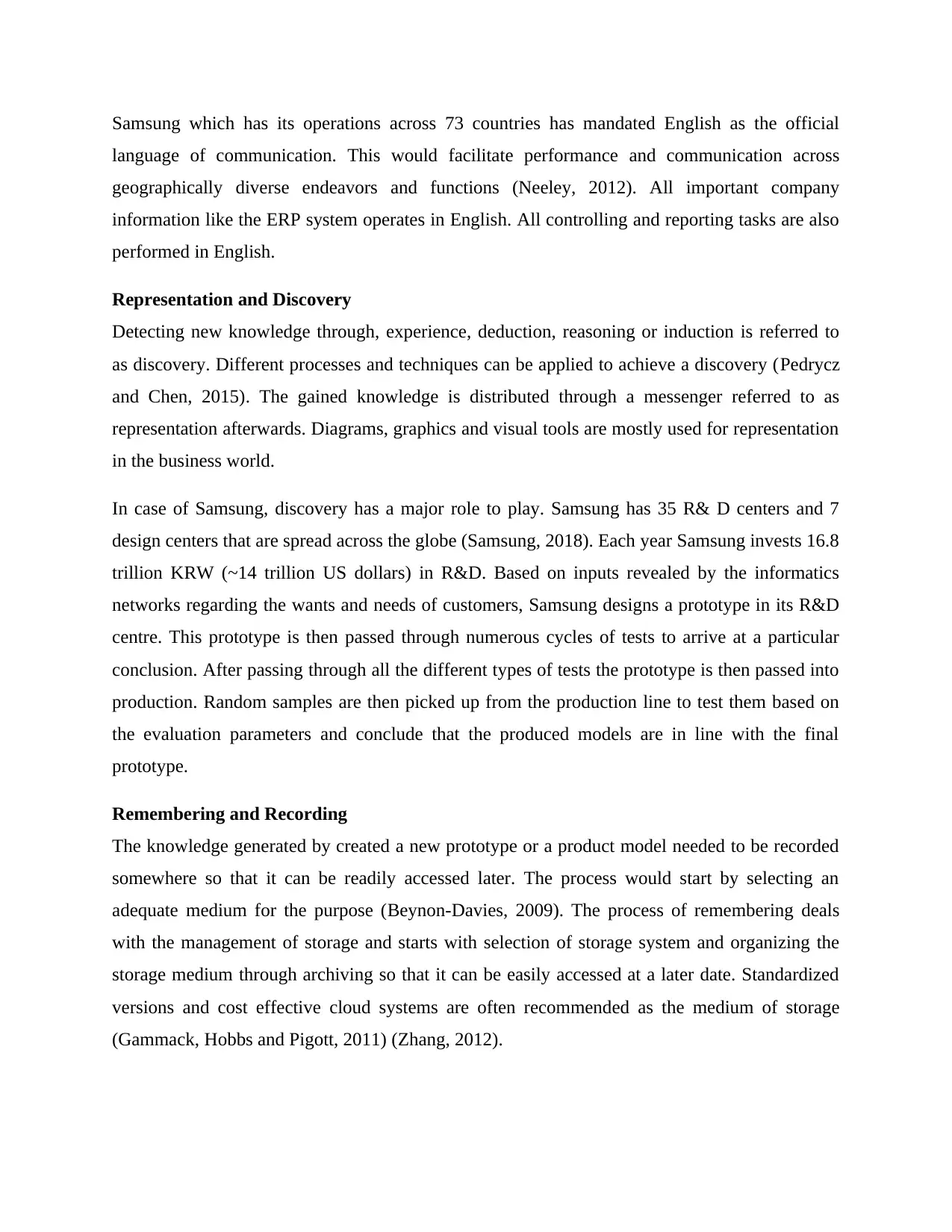
Samsung which has its operations across 73 countries has mandated English as the official
language of communication. This would facilitate performance and communication across
geographically diverse endeavors and functions (Neeley, 2012). All important company
information like the ERP system operates in English. All controlling and reporting tasks are also
performed in English.
Representation and Discovery
Detecting new knowledge through, experience, deduction, reasoning or induction is referred to
as discovery. Different processes and techniques can be applied to achieve a discovery (Pedrycz
and Chen, 2015). The gained knowledge is distributed through a messenger referred to as
representation afterwards. Diagrams, graphics and visual tools are mostly used for representation
in the business world.
In case of Samsung, discovery has a major role to play. Samsung has 35 R& D centers and 7
design centers that are spread across the globe (Samsung, 2018). Each year Samsung invests 16.8
trillion KRW (~14 trillion US dollars) in R&D. Based on inputs revealed by the informatics
networks regarding the wants and needs of customers, Samsung designs a prototype in its R&D
centre. This prototype is then passed through numerous cycles of tests to arrive at a particular
conclusion. After passing through all the different types of tests the prototype is then passed into
production. Random samples are then picked up from the production line to test them based on
the evaluation parameters and conclude that the produced models are in line with the final
prototype.
Remembering and Recording
The knowledge generated by created a new prototype or a product model needed to be recorded
somewhere so that it can be readily accessed later. The process would start by selecting an
adequate medium for the purpose (Beynon-Davies, 2009). The process of remembering deals
with the management of storage and starts with selection of storage system and organizing the
storage medium through archiving so that it can be easily accessed at a later date. Standardized
versions and cost effective cloud systems are often recommended as the medium of storage
(Gammack, Hobbs and Pigott, 2011) (Zhang, 2012).
language of communication. This would facilitate performance and communication across
geographically diverse endeavors and functions (Neeley, 2012). All important company
information like the ERP system operates in English. All controlling and reporting tasks are also
performed in English.
Representation and Discovery
Detecting new knowledge through, experience, deduction, reasoning or induction is referred to
as discovery. Different processes and techniques can be applied to achieve a discovery (Pedrycz
and Chen, 2015). The gained knowledge is distributed through a messenger referred to as
representation afterwards. Diagrams, graphics and visual tools are mostly used for representation
in the business world.
In case of Samsung, discovery has a major role to play. Samsung has 35 R& D centers and 7
design centers that are spread across the globe (Samsung, 2018). Each year Samsung invests 16.8
trillion KRW (~14 trillion US dollars) in R&D. Based on inputs revealed by the informatics
networks regarding the wants and needs of customers, Samsung designs a prototype in its R&D
centre. This prototype is then passed through numerous cycles of tests to arrive at a particular
conclusion. After passing through all the different types of tests the prototype is then passed into
production. Random samples are then picked up from the production line to test them based on
the evaluation parameters and conclude that the produced models are in line with the final
prototype.
Remembering and Recording
The knowledge generated by created a new prototype or a product model needed to be recorded
somewhere so that it can be readily accessed later. The process would start by selecting an
adequate medium for the purpose (Beynon-Davies, 2009). The process of remembering deals
with the management of storage and starts with selection of storage system and organizing the
storage medium through archiving so that it can be easily accessed at a later date. Standardized
versions and cost effective cloud systems are often recommended as the medium of storage
(Gammack, Hobbs and Pigott, 2011) (Zhang, 2012).
Paraphrase This Document
Need a fresh take? Get an instant paraphrase of this document with our AI Paraphraser

All information regarding new prototypes at Samsung electronics are stored in knowledge based
system so that the know how is conserved. All financial data belonging to the last 10 years are
also conserved by Samsung electronics in ERP based systems. All the financial transactions are
carried out in paper less electronic system for the ease of recording and storage.
Systematization and Construction
Within long lasting structures the records are organized based on construction and
systematization. Stored information’s structure is decided by the data modeling (Gammack,
Hobbs and Pigott, 2011). The operational and financial data of Samsung electronics are
organized within different categories at Samsung. There is a primary key in each of the data sets
and further characteristics are loaded in the content.
Conclusion
Within the above pages the classical themes of informatics was applied to Samsung. Being
located in more than 73 countries with billions of customers across the globe Samsung generates
tremendous amounts of data. Additionally the challenges that the company faces in different
countries are also uniquely different. In order to address its business concerns and the
multifarious challenges that it faces across the world, informatics can help. From proper naming
of the different departments, to making a discovery and storing the informatics in a systematic
manner, informatics is at play at every stage of the processes. Going forward informatics is going
to play even more vital role as the company tries to better understand and predict customer
behaviors soi as to retain its dominant position in the market (Mankotia, 2015).
system so that the know how is conserved. All financial data belonging to the last 10 years are
also conserved by Samsung electronics in ERP based systems. All the financial transactions are
carried out in paper less electronic system for the ease of recording and storage.
Systematization and Construction
Within long lasting structures the records are organized based on construction and
systematization. Stored information’s structure is decided by the data modeling (Gammack,
Hobbs and Pigott, 2011). The operational and financial data of Samsung electronics are
organized within different categories at Samsung. There is a primary key in each of the data sets
and further characteristics are loaded in the content.
Conclusion
Within the above pages the classical themes of informatics was applied to Samsung. Being
located in more than 73 countries with billions of customers across the globe Samsung generates
tremendous amounts of data. Additionally the challenges that the company faces in different
countries are also uniquely different. In order to address its business concerns and the
multifarious challenges that it faces across the world, informatics can help. From proper naming
of the different departments, to making a discovery and storing the informatics in a systematic
manner, informatics is at play at every stage of the processes. Going forward informatics is going
to play even more vital role as the company tries to better understand and predict customer
behaviors soi as to retain its dominant position in the market (Mankotia, 2015).

Reference
Beynon-Davies, P. (2009) Neolithic informatics: The nature of information. International
journal of information management, 29(1), pp.3-14.
Beynon-Davies, P. (2013) Business information systems. London: Macmillan International
Higher Education.
Business vibes. (2015) The Importance of Information Technology in business today. [online].
Available from: < https://www.business2community.com/tech-gadgets/importance-information-
technology-business-today-01393380>[Accessed 09 April 2019].
Gammack, J.G, Hobbs, V and Pigott, D. (2011) The book of informatics. South Melbourne:
Cengage Learning,
Jahagirdar, N. (2016) Samsung’s Viv joins the battle of bots. [online]. Available from: <
https://digerati.org/samsungs-viv-joins-the-battle-of-bots/ >[Accessed 09 April 2019].
Liu, C. (2018) Samsung's hopes for reviving Galaxy in China are under threat. [online].
Available from: <https://asia.nikkei.com/Business/Business-trends/Samsung-s-hopes-for-
reviving-Galaxy-in-China-are-under-threat >[Accessed 10 April 2019].
Mankotia, A. (2015) Facebook partners Samsung, Micromax and Airtel with targeted ads.
[online]. Available from: < https://economictimes.indiatimes.com/tech/internet/facebook-
partners-samsung-micromax-and-airtel-with-targeted-ads/articleshow/50032763.cms
>[ Accessed 09 April 2019].
Neeley, T. (2012) Global business speaks English. [online]. Available from: <
https://hbr.org/2012/05/global-business-speaks-english >[Accessed 11 April 2019].
Pedrycz, W. and Chen, S.M. (2015). Granular computing and decision-making: interactive and
iterative approaches. Berlin: Springer
Samsung (2015) Sustainability report. [online]. Available from: <
https://images.samsung.com/is/content/samsung/p5/global/ir/docs/SAMSUNG_SUSTAINABILI
TY_REPORT_2015_ENG.pdf >[Accessed 09 April 2019].
Beynon-Davies, P. (2009) Neolithic informatics: The nature of information. International
journal of information management, 29(1), pp.3-14.
Beynon-Davies, P. (2013) Business information systems. London: Macmillan International
Higher Education.
Business vibes. (2015) The Importance of Information Technology in business today. [online].
Available from: < https://www.business2community.com/tech-gadgets/importance-information-
technology-business-today-01393380>[Accessed 09 April 2019].
Gammack, J.G, Hobbs, V and Pigott, D. (2011) The book of informatics. South Melbourne:
Cengage Learning,
Jahagirdar, N. (2016) Samsung’s Viv joins the battle of bots. [online]. Available from: <
https://digerati.org/samsungs-viv-joins-the-battle-of-bots/ >[Accessed 09 April 2019].
Liu, C. (2018) Samsung's hopes for reviving Galaxy in China are under threat. [online].
Available from: <https://asia.nikkei.com/Business/Business-trends/Samsung-s-hopes-for-
reviving-Galaxy-in-China-are-under-threat >[Accessed 10 April 2019].
Mankotia, A. (2015) Facebook partners Samsung, Micromax and Airtel with targeted ads.
[online]. Available from: < https://economictimes.indiatimes.com/tech/internet/facebook-
partners-samsung-micromax-and-airtel-with-targeted-ads/articleshow/50032763.cms
>[ Accessed 09 April 2019].
Neeley, T. (2012) Global business speaks English. [online]. Available from: <
https://hbr.org/2012/05/global-business-speaks-english >[Accessed 11 April 2019].
Pedrycz, W. and Chen, S.M. (2015). Granular computing and decision-making: interactive and
iterative approaches. Berlin: Springer
Samsung (2015) Sustainability report. [online]. Available from: <
https://images.samsung.com/is/content/samsung/p5/global/ir/docs/SAMSUNG_SUSTAINABILI
TY_REPORT_2015_ENG.pdf >[Accessed 09 April 2019].

Samsung (2018) Samsung Electronics sustainability report 2018. [online]. Available from: <
https://images.samsung.com/is/content/samsung/p5/global/ir/docs/SustainabilityReport2018_en.
pdf >[Accessed 09 April 2019].
Zhang, Y. (2012) Future wireless networks and information systems. [online]. Berlin/Heidelberg:
Springer- Verlag,
https://images.samsung.com/is/content/samsung/p5/global/ir/docs/SustainabilityReport2018_en.
pdf >[Accessed 09 April 2019].
Zhang, Y. (2012) Future wireless networks and information systems. [online]. Berlin/Heidelberg:
Springer- Verlag,
1 out of 10
Your All-in-One AI-Powered Toolkit for Academic Success.
+13062052269
info@desklib.com
Available 24*7 on WhatsApp / Email
![[object Object]](/_next/static/media/star-bottom.7253800d.svg)
Unlock your academic potential
© 2024 | Zucol Services PVT LTD | All rights reserved.

